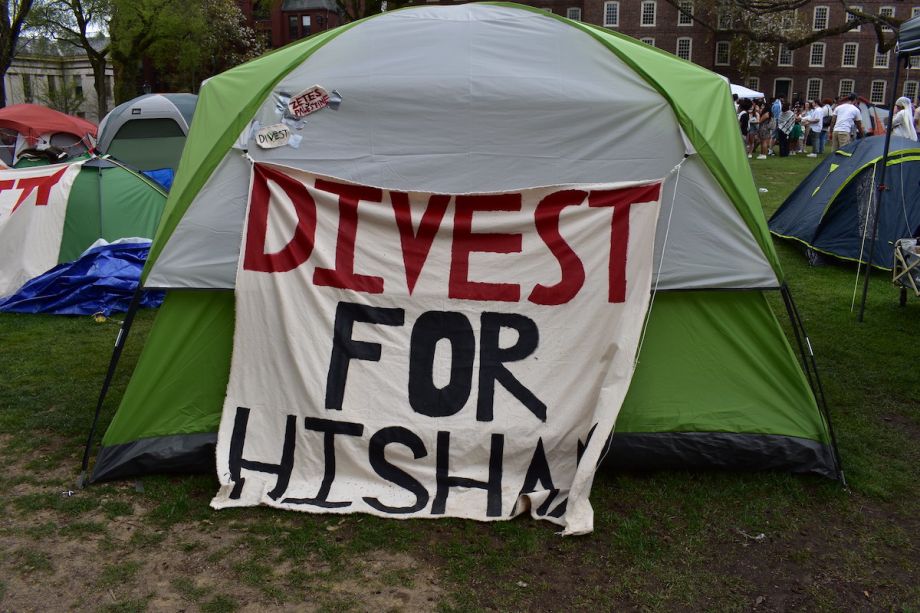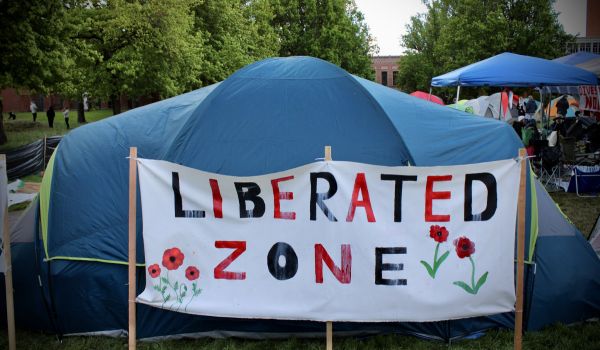With student uprisings for Gaza popping up on campuses in cities across the country, there’s an oldie but goodie going around, and I’m not talking about music. Here’s Thalia Beaty reporting for the Associated Press:
“Divest from death” read the bubble letters written in chalk on the sidewalk on Tuesday outside of The New School in New York City.
The slogan articulates one of the demands of the antiwar protests on campuses which call on colleges or universities to divest their endowments from companies profiting from the Israel-Hamas war.
Campaigns to pressure universities to divest for political or ethical reasons go back decades, at least to the 1970s when students pressured schools to withdraw from investments that benefited South Africa under apartheid rule. More recently, in the early aughts, schools made rules barring investments in things like alcohol, tobacco and gambling, according to a report from the National Association of College and University Business Officers (NACUBO) and Commonfund.
At around $400 million, The New School’s endowment is hardly the largest among New York’s many college and university campuses. That distinction of course goes to Columbia University, with its $13 billion endowment. Ithaca-based Cornell University, which has a major presence in New York City including its medical school, is not far behind at $10 billion. New York University, meanwhile, currently has a $6 billion endowment. The City University of New York system is a bit harder to tally up, as there are 27 foundations spread out across its 25 schools and colleges, but based on my quick scan of the system’s most recent consolidated financial statement it has what I would call a combined overall $1.4 billion endowment.
Add all those up and it still wouldn’t crack the top five endowments across the entire country: Princeton’s $34 billion, Stanford’s $36 billion, Yale’s $40 billion, The University of Texas’ $45 billion, and Harvard with $49.5 billion in its endowment.
In the most recent survey conducted by the National Association of College and University Business Officers, the endowments of 688 participating U.S. colleges and universities had $839.1 billion in assets. But most endowments were relatively small: The median endowment size was $209.1 million, and nearly one-third of study participants had endowments that were $100 million or less.
Colleges and universities of course aren’t the only tax-exempt institutions with investment portfolios that are supposed to benefit the public in some way. Foundations have more than $1 trillion in endowment assets — the investment portfolios they use to fund their operations and grantmaking. State and local public pension funds meanwhile have $6 trillion in their investment portfolios.
Divestment is a complex issue to tackle, even if an institution decides to do it. Institutions and also high net-worth individuals generally outsource the management of their wealth to the professional asset management industry — which is overwhelmingly white and male.
Out of $82.1 trillion in professionally-managed assets, only 1.4% of those dollars are entrusted by investors to asset management firms owned by women and/or people of color, despite those firms’ investment performance matching those of their less-diverse peers, according to a 2021 study funded by the Knight Foundation.
Asset management firms often pool dollars from multiple clients into larger funds that make many different investments, which may or may not be transparent to the clients themselves. Investment dollars may be tied up under legal contracts within the funds themselves or to the underlying investments selected by fund managers.
But it’s not impossible to divest. One strategy is being more intentional around the selection of asset management firms themselves. As I’ve covered previously, an increasing number of foundations have been making progress diversifying their stables of asset management firms.
I’ve also written about Black-led and women-led asset management firms that are also investing funds differently, using their own values-based lenses around racial, social and environmental justice, while still performing competitively on a financial basis. Some even identify as anti-racist or anti-capitalist asset management firms. Firms like these are still a very tiny slice of the asset management industry, contrary to what some governors and state legislators would lead you to believe with their calls to ban doing business with asset managers that use “environmental, social and governance” factors in their investment strategies.
Many still view values-based investing as a sacrifice, that you have to give up some financial return as a way to generate more social return. Maybe that’s true. But it can also be true at the same time that financial markets by their very design — dominated by so many from the same race, class and gender — are calibrated by default to produce the highest financial return only by pushing the bulk of the costs on those outside the group in power.
What you might consider “competitive market returns” may in fact represent only what’s possible when certain lives or the environment itself aren’t valued appropriately as a cost of doing business. If you have a hard time understanding that, then I may have a modest proposal to sell you.
This article is part of The Bottom Line, a series exploring scalable solutions for problems related to affordability, inclusive economic growth and access to capital. Click here to subscribe to our Bottom Line newsletter.

Oscar is Next City's senior economic justice correspondent. He previously served as Next City’s editor from 2018-2019, and was a Next City Equitable Cities Fellow from 2015-2016. Since 2011, Oscar has covered community development finance, community banking, impact investing, economic development, housing and more for media outlets such as Shelterforce, B Magazine, Impact Alpha and Fast Company.
Follow Oscar .(JavaScript must be enabled to view this email address)











_600_350_80_s_c1.jpg)







Add to the Discussion
Next City sustaining members can comment on our stories. Keep the discussion going! Join our community of engaged members by donating today.
Already a sustaining member? Login here.